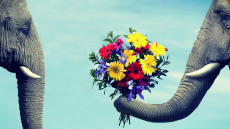
Email: ZYVC057@live.rhul.ac.uk
Total Article : 213
About Me:I'm a graduate student studying International Criminal Law and first started writing for King's News almost 4 years ago! My hobbies include reading, travelling and charity work. I cover many categories but my favourite articles to write are about mysteries of the ancient world, interesting places to visit, the Italian language and animals!

Another creature on the super cute and special animals list is the elephant, which is appealing not only due to its looks but also its behaviour. In fact, elephants don’t share the stereotypical ‘cute factors’ we abide by: they aren’t furry nor do they have big eyes, yet we find them attractive for other reasons.
Elephants are born with short trunks which grow extremely fast in the first few weeks of life, mastering how to move these growing trunks proves to be very difficult as their trunk has a mind all of its own – watching a baby elephant command his trunk is comical. For the elephant however mastering his trunk is essential to its very own survival, the trunk is not only used to smell things but is also used as a utensil, straw and snorkel which helps elephants carry out their daily activities. The trunk has not bones in it and works on muscles, stretching and tensing together just like our tongue. The trunks of elephants can have up to 14000 different muscles used for various tasks – getting the combination of so many muscles right is all about testing the waters through trial and error.
At only a year old elephants can use their trunks to lift things and carry out their daily routine. Our emotions are hit hard when we see these clumsy babies trying to get to grips with the trunks – clumsiness and learning both trigger our cuteness radar. They remind us of the struggle babies have to master their bodily actions, such as when children waddle which resembles the walk of a penguin for example. Why do penguins resort to wobbling though? The majority of a penguin’s life is spent in the ocean, where they abandon their slow waddling and use their torpedo-like shape to move quickly and smoothly. The largest penguins can hold their breath for half an hour reaching depths of half a kilometre and are great divers. Known as the Emperor penguin, it is 45 inches tall and lives on the Antarctic ice or the surrounding area. In order to cope with the extremely bitter environment, which can have winds reaching -76°F, the penguins cooperate with one another to survive. These penguins spend their long winters on the ice and even bread during the freezing season. When on land, nonetheless, their short legs and big feet don’t allow the penguins to travel at high speed. At first, scientists concluded that the waddling of penguins was highly inefficient and just wasted their energy but now we know that penguins barely use their leg muscles at all, recovering 80% of energy used for each stride to the next one. Whilst not being the most elegant of walks, the penguin’s waddle allows it to command both sea and land.
One of the reasons I really enjoyed watching this documentary is because it not only shows you some of the world’s most adorable animals, but it also explains why we are drawn to them in the first place. Also, by discovering the true function of the animal’s features, we can go beyond the ‘cute factor’ and understand the innate survival instinct which our furry, clumsy and just super cute animals all have!
Image: http://bycojcem.pl/wp-content/uploads/2014/06/Love-Images-of-Cute-Elephant-Giving-a-Flower-to-Her-Lover.jpg

0 Comment:
Be the first one to comment on this article.